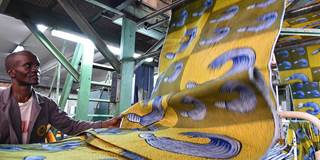Since its implementation in 2000, the African Growth and Opportunity Act has supported a wave of "Made in Africa" success stories. But AGOA will expire in 2025, leaving African countries nine years to consolidate the progress they have made.
ABIDJAN, CÔTE D’IVOIRE – If you’re ever shopping for a pair of jeans in an American mall, check the label. If it was made in, say, Lesotho – a tiny mountainous country surrounded by South Africa, with a population of around two million – you probably have the the African Growth and Opportunity Act (AGOA) to thank for it.
The AGOA, which was implemented in 2000, allows more than 6,400 products from eligible sub-Saharan African countries to enter the United States market duty-free. According to Lesotho’s National AGOA Strategy, the country’s annual garment exports to the US increased from about $129 million in 2001 to $330 million in 2015, representing 80% of total external demand for the country’s textiles and garments. With 44,000 employees, Lesotho’s garment industry is now the country’s largest private-sector employer.
The AGOA has underpinned other “Made in Africa” success stories, too. Some may complain that the AGOA favors petroleum products, but the figures speak for themselves. According to the 2016 AGOA report, released by the Office of the US Trade Representative, non-oil exports to the US under AGOA nearly tripled, from $1.4 billion in 2001 to $4.1 billion in 2015. Automobiles from South Africa and apparel from Kenya, Lesotho, Mauritius, and Swaziland were the leading exports.

ABIDJAN, CÔTE D’IVOIRE – If you’re ever shopping for a pair of jeans in an American mall, check the label. If it was made in, say, Lesotho – a tiny mountainous country surrounded by South Africa, with a population of around two million – you probably have the the African Growth and Opportunity Act (AGOA) to thank for it.
The AGOA, which was implemented in 2000, allows more than 6,400 products from eligible sub-Saharan African countries to enter the United States market duty-free. According to Lesotho’s National AGOA Strategy, the country’s annual garment exports to the US increased from about $129 million in 2001 to $330 million in 2015, representing 80% of total external demand for the country’s textiles and garments. With 44,000 employees, Lesotho’s garment industry is now the country’s largest private-sector employer.
The AGOA has underpinned other “Made in Africa” success stories, too. Some may complain that the AGOA favors petroleum products, but the figures speak for themselves. According to the 2016 AGOA report, released by the Office of the US Trade Representative, non-oil exports to the US under AGOA nearly tripled, from $1.4 billion in 2001 to $4.1 billion in 2015. Automobiles from South Africa and apparel from Kenya, Lesotho, Mauritius, and Swaziland were the leading exports.